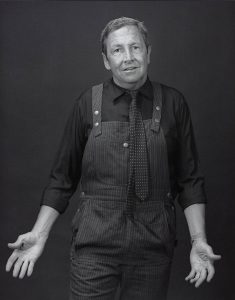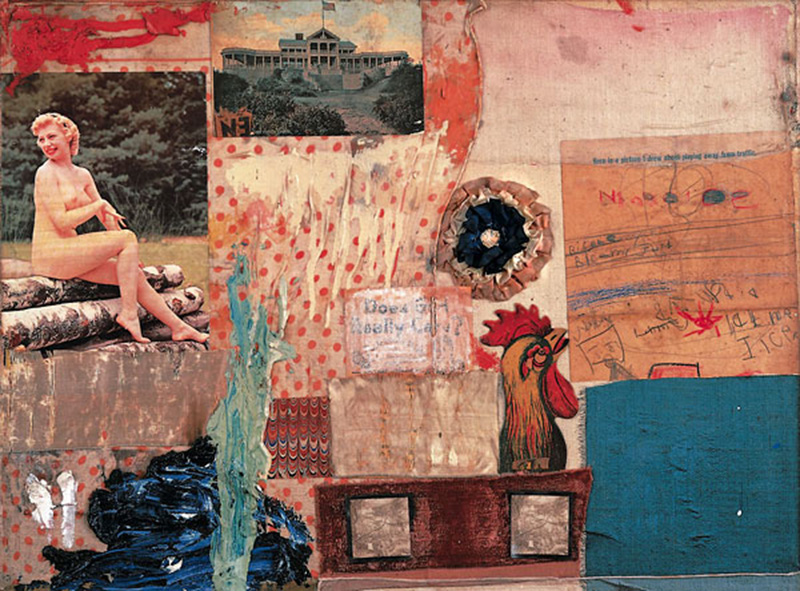TRACES:Robert Rauschenberg
 Today is the occasion to bear in mind Robert Rauschenberg (22/10/1925-12/5/2008). Building on European Dada and Surrealism, notably Marcel Duchamp and Kurt Schwitters, Robert Rauschenberg formed a link between Abstract Expressionsim and Pop Art, Conceptual, Performance and Process Art. This column is a tribute to artists, living or dead, who have left their mark in Contemporary Art. Through documents or interviews, starting with: moments and memories, we reveal out from the past-unknown sides of big personalities, who left their indelible traces in time and history…
Today is the occasion to bear in mind Robert Rauschenberg (22/10/1925-12/5/2008). Building on European Dada and Surrealism, notably Marcel Duchamp and Kurt Schwitters, Robert Rauschenberg formed a link between Abstract Expressionsim and Pop Art, Conceptual, Performance and Process Art. This column is a tribute to artists, living or dead, who have left their mark in Contemporary Art. Through documents or interviews, starting with: moments and memories, we reveal out from the past-unknown sides of big personalities, who left their indelible traces in time and history…
By Efi Michalarou
 Rauschenberg studied pharmacology at the University of Texas, Austin, before being drafted for the WW II as a neuropsychiatry technician in the Navy Reserve. The war was to prove his liberation. He was first inspired to be an artist from visiting the Huntington Art Gallery when stationed in California and, after demob, the GI Bill paid for him to go to Europe, where he studied in Paris at the Académie Julian. There he met his future wife, the painter Susan Weil, and she persuaded him to study at the progressive Black Mountain College, where the veteran abstract painter Josef Albers proved a formidable influence. On graduating, Rauschenberg moved to New York, where he attracted attention with silhouetted negatives made with blueprint paper, one of them illustrated in Life magazine. In New York he met the avant-garde and Zen-oriented composer, John Cage, with whom he taught at Black Mountain and collaborated on a Futurist/Dada happening. The ‘50s were a particularly fertile period and many of Rauschenberg’s most famous (at the time notorious) work dates from this decade. Much of it derived from the egalitarian belief that everything had a place in art and that the artist was not a superior being. His monochrome paintings not only challenged king-of-the-castle gestural feats of self-expressionism, but equated with Cage’s musical use of silence, which never was truly silent, as an active component. His most notorious early work was “Erased de Kooning Drawing” (1953). With deep trepidation, Rauschenberg asked one of the alpha males of Abstract Expressionism, Willem de Kooning, if he could have one of his drawings to destroy in this way. De Kooning did not approve, but in the end gave the young artist the most difficult to rub out. He was right. It took Rauschenberg three weeks and 15 different rubbers to achieve his witty desecration and homage. Rauschenberg’s homosexual preference ended his marriage in 1952 and soon led to an artistically productive relationship over a decade long with his contemporary Jasper Johns. Initially, they sometimes collaborated on window displays for Tiffany and other uptown New York department stores, but were soon established as the twin stars of the most glamorous of the new galleries, Leo Castelli. Rauschenberg rapidly evolved his embedded surfaces into what he called “Combines”, loading his canvases with objects so that they eventually became free-standing works, half paintings/half sculptures. “Monogram” (1959) includes a stuffed goat wedged inside a car tyre, he also made tyre print paintings by running paint-covered tyres across paper. In 1984, Rauschenberg combined his interest in traveling with his belief that art could change society, founding the Rauschenberg Overseas Culture Interchange (R.O.C.I.). He traveled primarily to developing nations and Communist countries, in defiance of then-current American Cold War policies, learning craft traditions from the host country’s artists and artisans. Each of the twelve trips resulted in a major exhibition of Rauschenberg’s works inspired by the host country. Latterly he worked on ever more ambitious projects and collaborations, one accurately described as “The ¼ mile or 2 Furlong Piece”. This extremism, always a tendency, was encouraged by working with an army of assistants in a two-storey, 17,000ft studio on Captiva Island, off the Florida coast. He maintained this protean activity even after suffering the partial paralysis of a stroke in 2002.
Rauschenberg studied pharmacology at the University of Texas, Austin, before being drafted for the WW II as a neuropsychiatry technician in the Navy Reserve. The war was to prove his liberation. He was first inspired to be an artist from visiting the Huntington Art Gallery when stationed in California and, after demob, the GI Bill paid for him to go to Europe, where he studied in Paris at the Académie Julian. There he met his future wife, the painter Susan Weil, and she persuaded him to study at the progressive Black Mountain College, where the veteran abstract painter Josef Albers proved a formidable influence. On graduating, Rauschenberg moved to New York, where he attracted attention with silhouetted negatives made with blueprint paper, one of them illustrated in Life magazine. In New York he met the avant-garde and Zen-oriented composer, John Cage, with whom he taught at Black Mountain and collaborated on a Futurist/Dada happening. The ‘50s were a particularly fertile period and many of Rauschenberg’s most famous (at the time notorious) work dates from this decade. Much of it derived from the egalitarian belief that everything had a place in art and that the artist was not a superior being. His monochrome paintings not only challenged king-of-the-castle gestural feats of self-expressionism, but equated with Cage’s musical use of silence, which never was truly silent, as an active component. His most notorious early work was “Erased de Kooning Drawing” (1953). With deep trepidation, Rauschenberg asked one of the alpha males of Abstract Expressionism, Willem de Kooning, if he could have one of his drawings to destroy in this way. De Kooning did not approve, but in the end gave the young artist the most difficult to rub out. He was right. It took Rauschenberg three weeks and 15 different rubbers to achieve his witty desecration and homage. Rauschenberg’s homosexual preference ended his marriage in 1952 and soon led to an artistically productive relationship over a decade long with his contemporary Jasper Johns. Initially, they sometimes collaborated on window displays for Tiffany and other uptown New York department stores, but were soon established as the twin stars of the most glamorous of the new galleries, Leo Castelli. Rauschenberg rapidly evolved his embedded surfaces into what he called “Combines”, loading his canvases with objects so that they eventually became free-standing works, half paintings/half sculptures. “Monogram” (1959) includes a stuffed goat wedged inside a car tyre, he also made tyre print paintings by running paint-covered tyres across paper. In 1984, Rauschenberg combined his interest in traveling with his belief that art could change society, founding the Rauschenberg Overseas Culture Interchange (R.O.C.I.). He traveled primarily to developing nations and Communist countries, in defiance of then-current American Cold War policies, learning craft traditions from the host country’s artists and artisans. Each of the twelve trips resulted in a major exhibition of Rauschenberg’s works inspired by the host country. Latterly he worked on ever more ambitious projects and collaborations, one accurately described as “The ¼ mile or 2 Furlong Piece”. This extremism, always a tendency, was encouraged by working with an army of assistants in a two-storey, 17,000ft studio on Captiva Island, off the Florida coast. He maintained this protean activity even after suffering the partial paralysis of a stroke in 2002.










